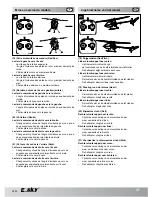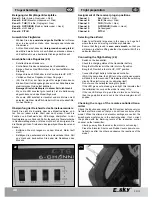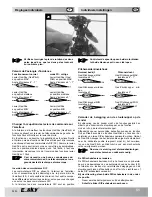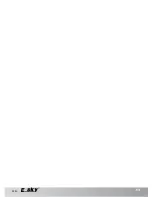
05/10
48
Flugvorbereitung
Flight preparation
Lehrer/Schüler-Betrieb
Für erste Trainingsflüge sollten Sie die Hilfe eines erfahrenen
Modellpiloten in Anspruch nehmen.
Dazu können Sie Ihren Fernsteuersender über ein
Lehrer/
Schüler-Kabel
(nicht im Lieferumfang) mit einer gleichar-
tigen Fernsteueranlage eines anderen Piloten verbinden.
Die Anschlussbuchse Ihres Senders befindet sich auf der
Rückseite.
Der Schülersender bleibt dabei ausgeschaltet!
Die Stromversorgung erfolgt über den Lehrer-
sender.
Verbinden Sie die Sender mit dem Lehrer/Schülerkabel.
Schalten Sie erst den Lehrersender, dann das Modell ein.
Das Modell wird jetzt ausschließlich vom Lehrer-Sender
kontrolliert.
Mit dem Lehrer/Schüler-Taster am Lehrersender kann der
Lehrer die Kontrolle an den Schülersender übergeben, solan-
ge der Taster gehalten wird. Der Lehrer/Schüler-Taster am
Schülersender ist ausser Funktion.
Stellen Sie sicher, dass das Modell einwandfrei auf die
Steuersignale beider Sender reagiert.
Überprüfen Sie erst den Lehrersender.
Halten Sie den Lehrer/Schüler-Taster und prüfen Sie, ob das
Modell auch einwandfrei auf den Schülersender reagiert.
Sobald der Taster losgelassen wird, ist die Kontrolle des
Helikopters wieder beim Lehrersender.
Wenn der Lehrer das Modell in eine stabile Fluglage gebracht
hat, kann er mit dem Lehrer/Schüler-Taster die Steuerung zeit-
weise an den Schüler übergeben.
Der Schüler kann so die Beherrschung des Modells trainieren
und der Lehrer bei Bedarf jederzeit wieder die Kontrolle über-
nehmen.
Individuelle Einstellungen
Einstellen des Spurlaufes
Für ein präzises Steuer- und Flugverhalten des Helikopters
muss sichergestellt sein, dass beide Rotorblätter exakt in einer
Ebene laufen.
Lassen Sie den Rotor drehen, während das Modell am Bo-
den steht.
Betrachten Sie die Blattspitzen in Richtung der Rotations-
ebene.
An Hand der farbigen Markierungen an den Blattspitzen können
Sie erkennen, ob sich beide Blätter am selben Umlaufpunkt in
gleicher Höhe befinden.
Sollte dies nicht der Fall sein (26), korrigieren Sie die Umlaufhöhe
beider
Blätter über eine Verstellung des Anstellwinkels (27).
Lösen Sie den Kugelkopf der Pitchanlenkung an der Taumel-
scheibe und drehen Sie diesen, um das Anlenkgestänge zu
verlängern oder einzukürzen (28).
Eine Drehung im Uhrzeigersinn erhöht den Anstellwinkel,
das Blatt bekommt mehr Auftrieb und läuft höher.
Eine Drehung gegen den Uhrzeigersinn vermindert den An-
stellwinkel und damit den Auftrieb, das Blatt läuft niedriger.
-
-
-
-
-
Trainer/Pupil Operation
You should enlist the help of an experienced model pilot for your
initial training flights.
To do so, use an trainer/pupil cable (not included with model)
to link your RC transmitter to another pilot‘s RC system of the
same type. The connector socket for your transmitter is located
on its rear side.
The pupil‘s transmitter remains switched off
when this is done. The power supply is provi-
ded via the trainer‘s transmitter.
Connect the transmitters with the trainer/pupil cable.
First switch on the trainer‘s transmitter, then the model.
The model will then be controlled only by the trainer‘s
transmitter.
Using the trainer/pupil button on the trainer‘s transmitter, the
trainer can hand over control to the pupil‘s transmitter as long as
the button is pressed.
The trainer/pupil button on the pupil‘s transmitter does not
function.
Make sure the model responds acceptably to the control
signals from both transmitters.
First check the trainer‘s transmitter.
Press and hold down the trainer/pupil button, and check
whether the model responds acceptably to the pupil‘s trans-
mitter.
As soon as the button is released, the control of the heli-
copter is back to the instructor‘s transmitter.
When the instructor has brought the model into a stable attitude,
he or she can use the trainer/pupil button to hand control over to
the pupil from time to time.
This way the pupil can practice controlling the model, and the
trainer can at any time take back over control when necessary.
Individual settings
Setting the pitch
For a precise control and flight behaviour of the helicopter, both
the rotor blades must run in the same plane.
Let the rotor turn while allowing the model to stand on the
ground.
Observe the tips in the direction of rotation.
On the basis of the colour markings on the tips, you can make
out whether both the blades are at the same circulation point at
the same height.
If not (26), adjust the circulation height of both the blades by
adjusting the angle of attack (27).
Loosen the ball head of the pitch control on the swash plate
and turn it to extend or shorten the steering linkage (28).
If you turn it in the clockwise direction, the angle of attack
increases, the blade gets more lift and runs at a greater
height.
On the other hand, if you turn it in the anti-clockwise direc-
tion, the angle of attack decreases and thereby also the lift,
because of which the blade runs at a lower height.
-
-
-
-
-
-
-
-
-
-
-
















































